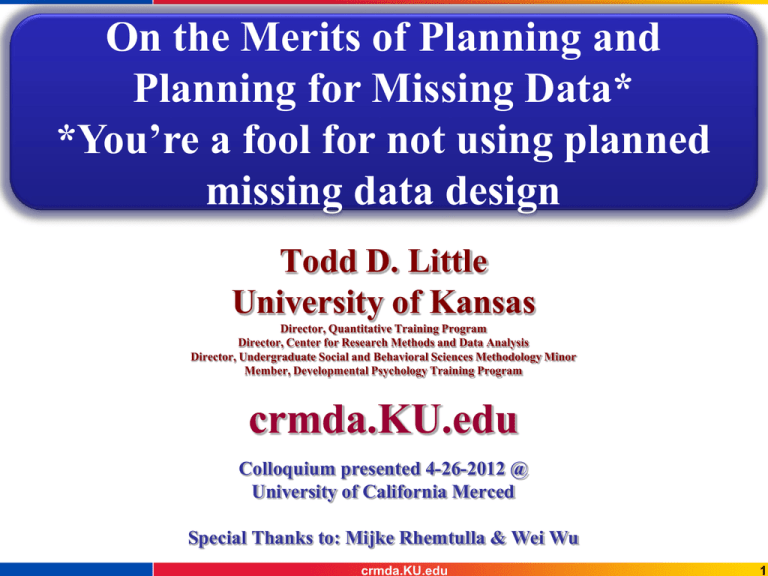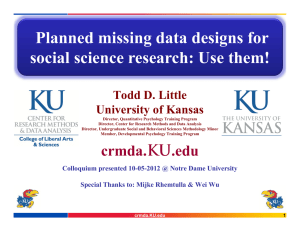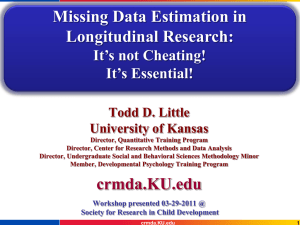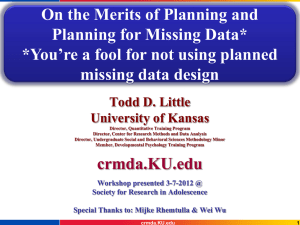On the Merits of Planning and Planning for Missing Data*
advertisement

On the Merits of Planning and Planning for Missing Data* *You’re a fool for not using planned missing data design Todd D. Little University of Kansas Director, Quantitative Training Program Director, Center for Research Methods and Data Analysis Director, Undergraduate Social and Behavioral Sciences Methodology Minor Member, Developmental Psychology Training Program crmda.KU.edu Colloquium presented 4-26-2012 @ University of California Merced Special Thanks to: Mijke Rhemtulla & Wei Wu crmda.KU.edu 1 Road Map • Learn about the different types of missing data • Learn about ways in which the missing data process can be recovered • Understand why imputing missing data is not cheating • Learn why NOT imputing missing data is more likely to lead to errors in generalization! • Learn about intentionally missing designs crmda.KU.edu 2 Key Considerations • Recoverability • • Is it possible to recover what the sufficient statistics would have been if there was no missing data? • (sufficient statistics = means, variances, and covariances) Is it possible to recover what the parameter estimates of a model would have been if there was no missing data. • Bias • Are the sufficient statistics/parameter estimates systematically different than what they would have been had there not been any missing data? • Power • Do we have the same or similar rates of power (1 – Type II error rate) as we would without missing data? crmda.KU.edu 3 Types of Missing Data • Missing Completely at Random (MCAR) • • No association with unobserved variables (selective process) and no association with observed variables Missing at Random (MAR) • No association with unobserved variables, but maybe related to observed variables • Random in the statistical sense of predictable • Non-random (Selective) Missing (MNAR) • Some association with unobserved variables and maybe with observed variables crmda.KU.edu 4 Effects of imputing missing data crmda.KU.edu 5 Effects of imputing missing data No Association with Observed Variable(s) An Association with Observed Variable(s) No Association with Unobserved /Unmeasured Variable(s) MCAR •Fully recoverable •Fully unbiased MAR • Partly to fully recoverable • Less biased to unbiased An Association with Unobserved /Unmeasured Variable(s) NMAR • Unrecoverable • Biased (same bias as not estimating) MAR/NMAR • Partly recoverable • Same to unbiased crmda.KU.edu 6 Effects of imputing missing data No Association with ANY Observed Variable An Association with Analyzed Variables An Association with Unanalyzed Variables No Association with Unobserved /Unmeasured Variable(s) MCAR •Fully recoverable •Fully unbiased MAR • Partly to fully recoverable • Less biased to unbiased MAR • Partly to fully recoverable • Less biased to unbiased An Association with Unobserved /Unmeasured Variable(s) NMAR • Unrecoverable • Biased (same bias as not estimating) MAR/NMAR • Partly to fully recoverable • Same to unbiased MAR/NMAR • Partly to fully recoverable • Same to unbiased Statistical Power: Will always be greater when missing data is imputed! crmda.KU.edu 7 Modern Missing Data Analysis MI or FIML • In 1978, Rubin proposed Multiple Imputation (MI) • • • • An approach especially well suited for use with large public-use databases. First suggested in 1978 and developed more fully in 1987. MI primarily uses the Expectation Maximization (EM) algorithm and/or the Markov Chain Monte Carlo (MCMC) algorithm. Beginning in the 1980’s, likelihood approaches developed. • • Multiple group SEM Full Information Maximum Likelihood (FIML). • An approach well suited to more circumscribed models crmda.KU.edu 8 Full Information Maximum Likelihood • FIML maximizes the case-wise -2loglikelihood of the available data to compute an individual mean vector and covariance matrix for every observation. • • Each individual likelihood function is then summed to create a combined likelihood function for the whole data frame. • • Since each observation’s mean vector and covariance matrix is based on its own unique response pattern, there is no need to fill in the missing data. Individual likelihood functions with greater amounts of missing are given less weight in the final combined likelihood function than those will a more complete response pattern, thus controlling for the loss of information. Formally, the function that FIML is maximizing is 2 i 1 Ki log i (yi i )i1 (yi i ) , N com where Ki pi log(2 ) crmda.KU.edu 9 Multiple Imputation • Multiple imputation involves generating m imputed datasets (usually between 20 and 100), running the analysis model on each of these datasets, and combining the m sets of results to make inferences. • • Data sets can be generated in a number of ways, but the two most common approaches are through an MCMC simulation technique such as Tanner & Wong’s (1987) Data Augmentation algorithm or through bootstrapping likelihood estimates, such as the bootstrapped EM algorithm used by Amelia II. • • By filling in m separate estimates for each missing value we can account for the uncertainty in that datum’s true population value. SAS uses data augmentation to pull random draws from a specified posterior distribution (i.e., stationary distribution of EM estimates). After m data sets have been created and the analysis model has been run on each separately, the resulting estimates are commonly combined with Rubin’s Rules (Rubin, 1987). crmda.KU.edu 10 Fraction Missing • • Fraction Missing is a measure of efficiency lost due to missing data. It is the extent to which parameter estimates have greater standard errors than they would have had, had all the data been observed. It is a ratio of variances: j 1 estimated parameter variance in the complete data set total parameter variance taking into account missingness Estimated parameter variance in the complete data set 1 sˆ 2j M M 2 ˆ s m m 1 Between-imputation variance M 1 2 ˆ ˆ Bˆ j ( ) m MI ,M M 1 m 1 crmda.KU.edu 11 Fraction Missing • Fraction of Missing Information (asymptotic formula) ˆ j 1 • • sˆ 2 j sˆ2j Bˆ j Varies by parameter in the model Is typically smaller for MCAR than MAR data crmda.KU.edu 12 60% MAR correlation estimates with 1 PCA auxiliary variable (r = .60) Figure 7. Simulation results showing XY correlation estimates (with 95 and 99% confidence intervals) associated with a 60% MAR Situation and 1 PCA auxiliary variable. crmda.KU.edu 13 Three-form design • What goes in the Common Set? Form Common Set X Variable Set A Variable Set B Variable Set C 1 ¼ of items ¼ of items ¼ of items missing 2 ¼ of items ¼ of items missing ¼ of items 3 ¼ of items missing ¼ of items ¼ of items crmda.KU.edu 14 Three-form design: Example • 21 questions made up of 7 3-question subtests Subtest Item Subtest Item Demographics How old are you? Are you male or female? What is your occupation? Extraversion Musical Taste What is your favorite genre of music? Do you like to listen to music while you work? Do you prefer music played loud or softly? I start conversations. I am the life of the party. I am comfortable around people. Neuroticism I get stressed out easily. I get irritated easily. I have frequent mood swings. Conscientiousness I am always prepared. I like order. I pay attention to details. Agreeableness I am interested in people. I have a soft heart. I take time out for others. Openness I have a rich vocabulary. I have excellent ideas. I have a vivid imagination. crmda.KU.edu 15 Three-form design: Example • Common Set (X) Subtest Item Subtest Item Demographics How old are you? Are you male or female? What is your occupation? Extraversion Musical Taste What is your favorite genre of music? Do you like to listen to music while you work? Do you prefer music played loud or softly? I start conversations. I am the life of the party. I am comfortable around people. Neuroticism I get stressed out easily. I get irritated easily. I have frequent mood swings. Conscientiousness I am always prepared. I like order. I pay attention to details. Agreeableness I am interested in people. I have a soft heart. I take time out for others. Openness I have a rich vocabulary. I have excellent ideas. I have a vivid imagination. crmda.KU.edu Three-form design: Example • Common Set (X) Subtest Item Subtest Item Demographics How old are you? Are you male or female? What is your occupation? Extraversion Musical Taste What is your favorite genre of music? Do you like to listen to music while you work? Do you prefer music played loud or softly? I start conversations. I am the life of the party. I am comfortable around people. Neuroticism I get stressed out easily. I get irritated easily. I have frequent mood swings. Conscientiousness I am always prepared. I like order. I pay attention to details. Agreeableness I am interested in people. I have a soft heart. I take time out for others. Openness I have a rich vocabulary. I have excellent ideas. I have a vivid imagination. crmda.ku.edu 17 Three-form design: Example • Set A Subtest Item Subtest Item Demographics How old are you? Are you male or female? What is your occupation? Extraversion Musical Taste What is your favorite genre of music? Do you like to listen to music while you work? Do you prefer music played loud or softly? I start conversations. I am the life of the party. I am comfortable around people. Neuroticism I get stressed out easily. I get irritated easily. I have frequent mood swings. Conscientiousness I am always prepared. I like order. I pay attention to details. Agreeableness I am interested in people. I have a soft heart. I take time out for others. Openness I have a rich vocabulary. I have excellent ideas. I have a vivid imagination. crmda.KU.edu 18 Three-form design: Example • Set B Subtest Item Subtest Item Demographics How old are you? Are you male or female? What is your occupation? Extraversion Musical Taste What is your favorite genre of music? Do you like to listen to music while you work? Do you prefer music played loud or softly? I start conversations. I am the life of the party. I am comfortable around people. Neuroticism I get stressed out easily. I get irritated easily. I have frequent mood swings. Conscientiousness I am always prepared. I like order. I pay attention to details. Agreeableness I am interested in people. I have a soft heart. I take time out for others. Openness I have a rich vocabulary. I have excellent ideas. I have a vivid imagination. crmda.KU.edu 19 Three-form design: Example • Set C Subtest Item Subtest Item Demographics How old are you? Are you male or female? What is your occupation? Extraversion Musical Taste What is your favorite genre of music? Do you like to listen to music while you work? Do you prefer music played loud or softly? I start conversations. I am the life of the party. I am comfortable around people. Neuroticism I get stressed out easily. I get irritated easily. I have frequent mood swings. swings. Conscientiousness I am always prepared. I like order. I pay attention to details. Agreeableness I am interested in people. I have a soft heart. I take time out for others. Openness I have a rich vocabulary. I have excellent ideas. I have a vivid imagination. crmda.KU.edu 20 Form 1 (XAB) Form 2 (XAC) Form 3 (XBC) How old are you? Are you male or female? What is your occupation? How old are you? Are you male or female? What is your occupation? How old are you? Are you male or female? What is your occupation? What is your favorite genre of What is your favorite genre of What is your favorite genre of music? music? music? Do you like to listen to music Do you like to listen to music Do you like to listen to music while you work? while you work? while you work? Do you prefer music played loud or Do you prefer music played loud or Do you prefer music played loud or softly? softly? softly? I have a rich vocabulary. I have excellent ideas. I have a rich vocabulary. I have a vivid imagination. I have excellent ideas. I have a vivid imagination. I start conversations. I am the life of the party. I start conversations. I am comfortable around people. I am the life of the party. I am comfortable around people. I get stressed out easily. I get irritated easily. I get stressed out easily. I have frequent mood swings. I get irritated easily. I have frequent mood swings. I am always prepared. I like order. I am always prepared. I pay attention to details. I like order. I pay attention to details. I am interested in people. I have a soft heart. I am interested in people. I take time out for others. I have a soft heart. I take time out for others. 21 Jazz 4 1 29 M server 5 1 27 M 6 2 21 7 2 8 4 4 -- 1 5 -- 1 2 -- 4 2 -- 3 2 -- soft 1 3 -- 2 2 -- 5 3 -- 4 1 -- 2 1 -- N soft 2 4 -- 5 5 -- 2 4 -- 5 1 -- 4 2 -- Metal N soft 1 3 -- 5 2 -- 2 1 -- 1 1 -- 4 2 -- chef Rock N soft 1 4 -- 5 1 -- 2 2 -- 5 3 -- 2 2 -- F painter Pop Y loud 4 -- 4 2 -- 1 1 -- 5 1 -- 5 5 -- 3 39 F librarian Alt N loud 1 -- 4 4 -- 3 4 -- 3 4 -- 2 4 -- 3 2 22 F server Ska N soft 4 -- 2 3 -- 3 3 -- 3 1 -- 2 5 -- 5 9 2 38 M doctor Punk N loud 1 -- 3 2 -- 2 2 -- 4 4 -- 1 3 -- 2 10 2 29 F statistician Pop N loud 4 -- 5 3 -- 4 5 -- 4 3 -- 2 3 -- 1 11 3 28 F chef Rock Y loud -- 3 3 -- 5 5 -- 5 4 -- 3 3 -- 2 5 12 3 25 M nurse Rock N soft -- 4 5 -- 2 2 -- 2 5 -- 4 5 -- 3 5 13 3 29 M lawyer Jazz Y soft -- 3 4 -- 3 2 -- 4 5 -- 4 5 -- 1 2 14 3 38 F accountant Metal N soft -- 3 1 -- 1 2 -- 3 3 -- 4 4 -- 5 4 15 3 21 F secretary Alt N loud -- 4 4 -- 1 2 -- 1 1 -- 5 3 -- 4 5 Genre Agree3 student Agree2 27 M Agree1 1 Consc3 3 Consc2 N Consc1 Funk Neuro3 musician Neuro2 F Neuro1 42 Extra3 1 Extra2 2 Extra1 professor Open3 Occupation F Open2 Sex 47 Open1 Age 1 Volume Form Work Music Participant 1 Classical N loud crmda.KU.edu 22 Expansions of 3-Form Design (Graham, Taylor, Olchowski, & Cumsille, 2006) crmda.KU.edu 23 Expansions of 3-Form Design (Graham, Taylor, Olchowski, & Cumsille, 2006) crmda.KU.edu 24 2-Method Planned Missing Design crmda.KU.edu 25 2-Method Planned Missing Design • Use when you have an ideal (highly valid) measure that • • is time-consuming or expensive By supplementing this measure with a less expensive or time-consuming measure, it is possible to increase total sample size and get higher power e.g., measuring stress • • Expensive measure = collect spit samples, measure cortisol Inexpensive measure = survey querying stressful thoughts • e.g., measuring intelligence • Expensive measure = WAIS IQ scale • Inexpensive measure = multiple choice IQ test • e.g., measuring smoking • Expensive measure = carbon monoxide measure • Inexpensive measure = self-report crmda.KU.edu 26 2-Method Planned Missing Design • Assumptions: • expensive measure is unbiased (i.e., valid) • inexpensive measure is systematically biased • Using both measures (on a subset of participants) • enables us to estimate and remove the bias from the inexpensive measure (for all participants) As the inexpensive measure gets more valid, fewer observations are needed on the expensive measure • If inexpensive measure is perfectly unbiased, we don’t need the expensive measure at all! crmda.KU.edu 27 2-Method Planned Missing Design Self-Report Bias SelfSelfReport 1 Report 2 CO Cotinine Smoking crmda.KU.edu 28 2-Method Planned Missing Design crmda.KU.edu 29 2-Method Planned Missing Design crmda.KU.edu 30 age grade student K 1 2 1 5;6 6;7 7;3 2 5;3 6;0 7;4 3 4;9 5;11 6;10 4 4;6 5;5 6;4 5 4;11 5;9 6;10 6 5;7 6;7 7;5 7 5;2 6;1 7;3 8 5;4 6;5 7;6 4;64;11 5;0- 5;65;5 5;11 crmda.KU.edu 6;0- 6;66;5 6;11 7;0- 7;67;5 7;11 31 Out of 3 waves, we create 7 waves of data with high missingness Allows for more finetuned age-specific growth modeling Even high amounts of missing data are not typically a problem for estimation age 4;64;11 5;0- 5;65;5 5;11 6;0- 6;66;5 6;11 5;6 6;7 5;3 4;9 4;6 6;0 5;11 5;5 4;11 7;0- 7;67;5 7;11 7;3 7;4 6;10 6;4 5;9 6;10 5;7 6;7 5;2 6;1 5;4 6;5 crmda.KU.edu 7;5 7;3 7;6 32 Growth-Curve Design Group Time 1 Time 2 Time 3 Time 4 Time 5 1 x x x x x 2 x x x x missing 3 x x x missing x 4 x x missing x x 5 x missing x x x 6 missing x x x x crmda.KU.edu 33 Growth Curve Design II Group Time 1 Time 2 Time 3 Time 4 Time 5 1 x x x x x 2 x x x missing missing 3 x x missing x missing 4 x missing x x missing 5 missing x x x missing 6 x x missing missing x 7 x missing x missing x 8 missing x x missing x 9 x missing missing x x 10 missing x missing x x 11 missing missing x x x crmda.KU.edu 34 Growth Curve Design II Group Time 1 Time 2 Time 3 Time 4 Time 5 1 x x x x x 2 x x x missing missing 3 x x missing x missing 4 x missing x x missing 5 missing x x x missing 6 x x missing missing x 7 x missing x missing x 8 missing x x missing x 9 x missing missing x x 10 missing x missing x x 11 missing missing x x x crmda.KU.edu 35 On the Merits of Planning and Planning for Missing Data* *You’re a fool for not using planned missing data design Thanks for your attention! Questions? crmda.KU.edu Colloquium presented 4-26-2012 @ University of California at Merced crmda.KU.edu 36 Update Dr. Todd Little is currently at Texas Tech University Director, Institute for Measurement, Methodology, Analysis and Policy (IMMAP) Director, “Stats Camp” Professor, Educational Psychology and Leadership Email: yhat@ttu.edu IMMAP (immap.educ.ttu.edu) Stats Camp (Statscamp.org) www.Quant.KU.edu 37







